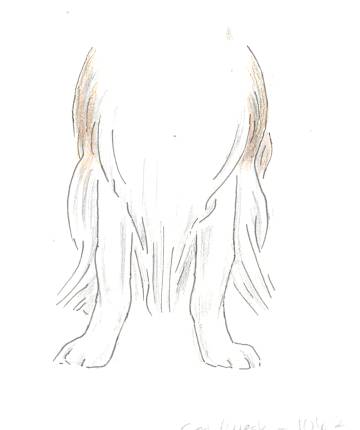

| ©2005 Ms D E Ashdown |
| (You are not permitted to copy any illustrations from this site - please note copyright warning on Home Page) |
|
FRONTS |
|
 |
 |
| A | B |
|
A shows three entirely straight
fronts, the legs descending in parallel columns from correctly position
elbows: the ribs are well developed and the chest is deep. The first
front is satisfactorily wide, the second is too narrow, the third much
too wide. But all are straight fronts. All have the same bone, which is
a little heavy. Note that the narrow front, with its closely positioned
leg columns, creates an impression of a slightly finer bone and
the very wide front the impression of slightly heavier bone die to the
overall proportions of the fronts. B illustrates a front with the "eat/west" or "ten to two" position and feet which are rather typical of the breed. This drawing shows a leggy dog to illustrate the point better. The legs are straight from correctly positioned elbows, but the pasterns are weak and turn out. Some papillons stand like this because the weakness in the pasterns compel them to do so, others irritatingly seem to adopt this position merely because they like to do so, and can stand, and move, perfectly straight in front when they choose to do so. |
|
|
|
|
| C | |
| C shows 6 incorrect types of front It is profoundly to be hoped that not too many such fronts would be seen in the show ring. In the case of a seriously bowed front, the problem can be created through excess weight, or the cumulative effects of old age. However fundamentally these fronts show serious constructional faults | |
|
|
|
|
D |
|
| In D the first two fronts show feet turned in - average and narrow fronts respectively. They are followe4d (top) by a correct straight front seen from the side, next to an "east/west" front. Underneath from left to right are a front with feet knuckling over, a narrow front seen from the side and a wide "toeing in" front. Finally a seriously deformed front with spindly twisted legs | |